Comparative Study of Mechanical Scaling Effects of Origami-Inspired Motion Generation Mechanisms with Multi-Degree Vertices
Abstract
:1. Introduction
2. Scaling Factor of Origami Structures
3. Oriceps
3.1. Kinematics
3.2. Scaling Factor
4. Miura Ori String
4.1. Kinematics
4.2. Scaling Factor
5. MACIOR Origami with a Six-Degree Vertex
5.1. Kinematics
5.2. Scaling Factor
6. Hexagonal Structures
6.1. Kinematics
6.1.1. Type 1
6.1.2. Type 2
6.2. Scaling Factor
6.2.1. Type 1
6.2.2. Type 2
7. Comparison of Different Structures
7.1. Simulation of Oriceps with Different Materials
7.2. Potential Design Concept and Usage in Four-Bar Mechanisms
7.3. Emerging Trends in Origami
8. Conclusions and Discussions
Author Contributions
Funding
Data Availability Statement
Conflicts of Interest
References
- Turner, N.; Goodwine, B.; Sen, M. A review of origami applications in mechanical engineering. Proc. Inst. Mech. Eng. Part J. Mech. Eng. Sci. 2016, 230, 2345–2362. [Google Scholar] [CrossRef]
- Balkcom, D.; Mason, M. Robotic origami folding. Int. J. Robot. Res. 2008, 27, 613–627. [Google Scholar] [CrossRef]
- Sapienza, V.; Rodonò, G. Kinetic Architecture and Foldable Surface. Athens J. Archit. 2016, 2, 223–236. [Google Scholar] [CrossRef]
- Nelson, T.G.; Zimmerman, T.K.; Magleby, S.P.; Lang, R.J.; Howell, L.L. Developable mechanisms on developable surfaces. Sci. Robot. 2019, 4, eaau5171. [Google Scholar] [CrossRef] [PubMed]
- Yao, W.; Dai, J. Dexterous manipulation of origami cartons with robotic fingers based on the interactive configuration space. J. Mech. Des. 2008, 130, 022303. [Google Scholar] [CrossRef]
- Chen, Y.; Peng, R.; You, Z. Origami of thick panels. Science 2015, 349, 396–400. [Google Scholar] [CrossRef] [PubMed]
- Edmondson, B.J.; Bowen, L.A.; Grames, C.L.; Magleby, S.P.; Howell, L.L.; Bateman, T.C. Oriceps: Origami-Inspired Forceps. In Smart Materials, Adaptive Structures and Intelligent Systems; American Society of Mechanical Engineers: New York, NY, USA, 2013; Volume 1. [Google Scholar] [CrossRef]
- von der Woerd, J.D.; Chudoba, R.; Hegger, J. Single-curved shell structure made out of textile-reinforced concrete plate using a folding technique. Proc. Iass Annu. Symp. 2013, 2013, 1–6. [Google Scholar]
- Yang, H.; Yeow, B.; Chang, T.; Li, K.; Fu, F.; Chen, P. Graphene Oxide-Enabled Synthesis of Metal Oxide Origamis for Soft Robotics. ACS Nano 2019, 13, 5410–5420. [Google Scholar] [CrossRef]
- Lee, M.J.T.; Yeow, B.S.; Cai, C.J.; Tse, Z.T.H.; Ren, H. Prototyping soft origami quad-bellows robots from single-bellows characterization. In Flexible Robotics in Medicine: A Design Journey of Motion Generation Mechanisms and Biorobotic System Development; Academic Press: Cambridge, MA, USA, 2020; pp. 19–37. [Google Scholar]
- Thomson, A.; Hao, C.T.S.; Yanhui, L.O. Modular origami joint operator to create bendable motions with multiple radii. In Flexible Robotics in Medicine: A Design Journey of Motion Generation Mechanisms and Biorobotic System Development; Academic Press: Cambridge, MA, USA, 2020; pp. 101–148. [Google Scholar]
- Rus, D.; Tolley, M. Design, fabrication and control of origami robots. Nat. Rev. Mater. 2018, 3, 101–112. [Google Scholar] [CrossRef]
- Abdul-Sater, K.; Winkler, M.M.; Irlinger, F.; Lueth, T.C. Three-Position Synthesis of Origami-Evolved, Spherically Constrained Spatial Revolute–Revolute Chains. J. Mech. Robot. 2015, 8, 011012. [Google Scholar] [CrossRef]
- Banerjee, H.; Kakde, S.; Ren, H. OrumBot: Origami-Based Deformable Robot Inspired by an Umbrella Structure. In Proceedings of the 2018 IEEE International Conference on Robotics and Biomimetics (ROBIO), Kuala Lumpur, Malaysia, 12–15 December 2018; pp. 910–915. [Google Scholar] [CrossRef]
- Matsuo, H.; Asada, H.H.; Takeda, Y. Design of a Novel Mutliple-DOF Extendable Arm With Rigid Components Inspired by a Deployable Origami Structure. IEEE Robot. Autom. Lett. 2020, 5, 2730–2737. [Google Scholar] [CrossRef]
- Lang, R.J.; Magleby, S.; Howell, L. Single Degree-of-Freedom Rigidly Foldable Cut Origami Flashers. J. Mech. Robot. 2016, 8, 031005. [Google Scholar] [CrossRef]
- Zimmermann, L.; Stankovic, T. Rigid and Flat Foldability of a Degree-Four Vertex in Origami. J. Mech. Robot. 2020, 12, 011004. [Google Scholar] [CrossRef]
- Lee, K.; Wang, Y.; Zheng, C. TWISTER Hand: Underactuated Robotic Gripper Inspired by Origami Twisted Tower. IEEE Trans. Robot. 2020, 36, 488–500. [Google Scholar] [CrossRef]
- Su, Y.; Fang, Z.; Zhu, W.; Sun, X.; Zhu, Y.; Wang, H.; Tang, K.; Huang, H.; Liu, S.; Wang, Z. A High-Payload Proprioceptive Hybrid Robotic Gripper with Soft Origamic Actuators. IEEE Robot. Autom. Lett. 2020, 5, 3003–3010. [Google Scholar] [CrossRef]
- Deshpande, A.R.; Ho, Z.T.; Ren, H. Origami-inspired bi-directional soft pneumatic actuator with integrated variable stiffness mechanism. In Proceedings of the 2017 18th International Conference on Advanced Robotics (ICAR), Hong Kong, China, 10–12 July 2017; pp. 417–421. [Google Scholar] [CrossRef]
- Salerno, M.; Firouzeh, A.; Paik, J. A Low Profile Electromagnetic Actuator Design and Model for an Origami Parallel Platform. J. Mech. Robot. 2017, 9, 041005. [Google Scholar] [CrossRef]
- Tolley, M.T.; Shepherd, R.F.; Karpelson, M.; Bartlett, N.W.; Galloway, K.C.; Wehner, M.; Nunes, R.; Whitesides, G.M.; Wood, R.J. An untethered jumping soft robot. In Proceedings of the 2014 IEEE/RSJ International Conference on Intelligent Robots and Systems, Chicago, IL, USA, 14–18 September 2014; pp. 561–566. [Google Scholar] [CrossRef]
- Banerjee, H.; Pusalkar, N. Single-Motor Controlled Tendon Driven Peristaltic Soft Origami Robot. J. Mech. Robot. 2018, 10, 064501. [Google Scholar] [CrossRef]
- Banerjee, H.; Li, T.; Ponraj, G.; Kumar, K.S.; Lim, C. Origami-Layer-Jamming Deployable Retractor with Variable Stiffness and Tactile Sensing. J. Mech. Robot. 2019, 12, 031010. [Google Scholar] [CrossRef]
- Taylor, A.J.; Slutzky, T.; Feuerman, L.; Ren, H.; Tokuda, J.; Nilsson, K.; Tse, Z.T. MR-Conditional SMA-Based Origami Joint. IEEE/ASME Trans. Mechatron. 2019, 24, 883–888. [Google Scholar] [CrossRef] [PubMed]
- Salerno, M.; Zhang, K.; Menciassi, A.; Dai, J.S. A Novel 4-DOF Origami Grasper with an SMA-Actuation System for Minimally Invasive Surgery. IEEE Trans. Robot. 2016, 32, 484–498. [Google Scholar] [CrossRef]
- Cai, C.J.; Xiao, X.; Kalairaj, M.S.K.; Lee, I.J.; Mugilvannan, A.K.; Yeow, B.S.; Tan, J.H.; Huang, H.; Ren, H. Diversified and Untethered Motion Generation Via Crease Patterning from Magnetically Actuated Caterpillar-Inspired Origami Robot. IEEE/ASME Trans. Mechatron. 2021, 26, 1678–1688. [Google Scholar] [CrossRef]
- Yang, H.; Yeow, B.S.; Li, Z.; Li, K.; Chang, T.; Jing, L.; Li, Y.; Ho, J.S.; Ren, H.; Chen, P.Y. Multifunctional metallic backbones for origami robotics with strain sensing and wireless communication capabilities. Sci. Robot. 2019, 4, eaax7020. [Google Scholar] [CrossRef]
- Zhai, Z.; Wang, Y.; Lin, K.; Wu, L.; Jiang, H. In situ stiffness manipulation using elegant curved origami. Sci. Adv. 2020, 6, eabe2000. [Google Scholar] [CrossRef]
- Qiu, C.; Zhang, K.; Dai, J. Repelling-Screw Based Force Analysis of Origami Mechanisms. J. Mech. Robot. 2016, 8, 031001. [Google Scholar] [CrossRef]
- Salamon, B.A.; Midha, A. An Introduction to Mechanical Advantage in Compliant Mechanisms. J. Mech. Des. 1998, 120, 311–315. [Google Scholar] [CrossRef]
- Hernandez, E.P.; Hartl, D.; Lagoudas, D. Active Origami: Modeling, Design, and Applications; Springer: Berlin/Heidelberg, Germany, 2019. [Google Scholar] [CrossRef]
- Bai, S.; Li, X.; Angeles, J. A review of spherical motion generation using either spherical parallel manipulators or spherical motors. Mech. Mach. Theory 2019, 140, 377–388. [Google Scholar] [CrossRef]
- Yip, H.M.; Li, P.; Navarro-Alarcon, D.; Wang, Z.; Liu, Y. A new circular-guided remote center of motion mechanism for assistive surgical robots. In Proceedings of the 2014 IEEE International Conference on Robotics and Biomimetics (ROBIO 2014), Bali, Indonesia, 5–10 December 2014; pp. 217–222. [Google Scholar] [CrossRef]
- Bowen, L.A.; Grames, C.L.; Magleby, S.P.; Lang, R.J.; Howell, L.L. An Approach for Understanding Action Origami as Kinematic Mechanisms. In Proceedings of the Volume 6B: 37th Mechanisms and Robotics Conference, Portland, OR, USA, 4–7 August 2013. [Google Scholar] [CrossRef]
- Huffman. Curvature and Creases: A Primer on Paper. IEEE Trans. Comput. 1976, 100, 1010–1019. [Google Scholar] [CrossRef]
- Farhang, K.; Zargar, Y.S. Design of Spherical 4R Mechanisms: Function Generation for the Entire Motion Cycle. J. Mech. Des. 1999, 121, 521–528. [Google Scholar] [CrossRef]
- Hernández, S.; Bai, S.; Angeles, J. The Design of a Chain of Spherical Stephenson Mechanisms for a Gearless Robotic Pitch-Roll Wrist. J. Mech. Des. 2006, 128, 422–429. [Google Scholar] [CrossRef]
- Hull, T.C.; Tachi, T. Double-line rigid origami. arXiv 2017, arXiv:1709.03210. [Google Scholar]
- Feng, H.; Peng, R.; Ma, J.; Chen, Y. Rigid Foldability of Generalized Triangle Twist Origami Pattern and Its Derived 6R Linkages. J. Mech. Robot. 2018, 10, 051003. [Google Scholar] [CrossRef]
- Fang, H.; Li, S.; Wang, K. Self-locking degree-4 vertex origami structures. Proc. R. Soc. Math. Phys. Eng. Sci. 2016, 472, 20160682. [Google Scholar] [CrossRef]
- Edmondson, B.J. Development of a Thickness Accommodation Technique for Origami-Inspired Design; Brigham Young University: Provo, UT, USA, 2015. [Google Scholar]
- Kamrava, S.; Mousanezhad, D.; Felton, S.M.; Vaziri, A. Programmable Origami Strings. Adv. Mater. Technol. 2018, 3, 1700276. [Google Scholar] [CrossRef]
- Miura, K. The Science of Miura-Ori: A Review. Origami 2009, 4, 87. [Google Scholar]
- Butler, J.; Bowen, L.; Wilcox, E.; Shrager, A.; Frecker, M.I.; von Lockette, P.; Simpson, T.W.; Lang, R.J.; Howell, L.L.; Magleby, S.P. A Model for Multi-Input Mechanical Advantage in Compliant and Origami-Based Mechanisms. J. Mech. Robot. 2018, 10, 061007. [Google Scholar] [CrossRef]
- Wilcox, E.W.; Shrager, A.; Bowen, L.; Frecker, M.; Lockette, P.V.; Simpson, T.; Magleby, S.; Lang, R.J.; Howell, L.L. Considering mechanical advantage in the design and actuation of an origami-based mechanism. In Proceedings of the ASME Design Engineering Technical Conference, 39th Mechanisms and Robotics Conference, Boston, MA, USA, 2–5 August 2015; ASME: New York, NY, USA, 2016. [Google Scholar] [CrossRef]
- Orlofsky, A.; Liu, C.; Kamrava, S.; Vaziri, A.; Felton, S.M. Mechanically Programmed Miniature Origami Grippers. In Proceedings of the 2020 IEEE International Conference on Robotics and Automation (ICRA), Paris, France, 31 May–31 August 2020; pp. 2872–2878. [Google Scholar] [CrossRef]
- Kamrava, S.; Liu, C.; Orlofsky, A.; Vaziri, A.; Felton, S. A Closed-form Solution for the Kinematics of Asymmetric Miura Vertices. arXiv 2020, arXiv:2001.07657. [Google Scholar]
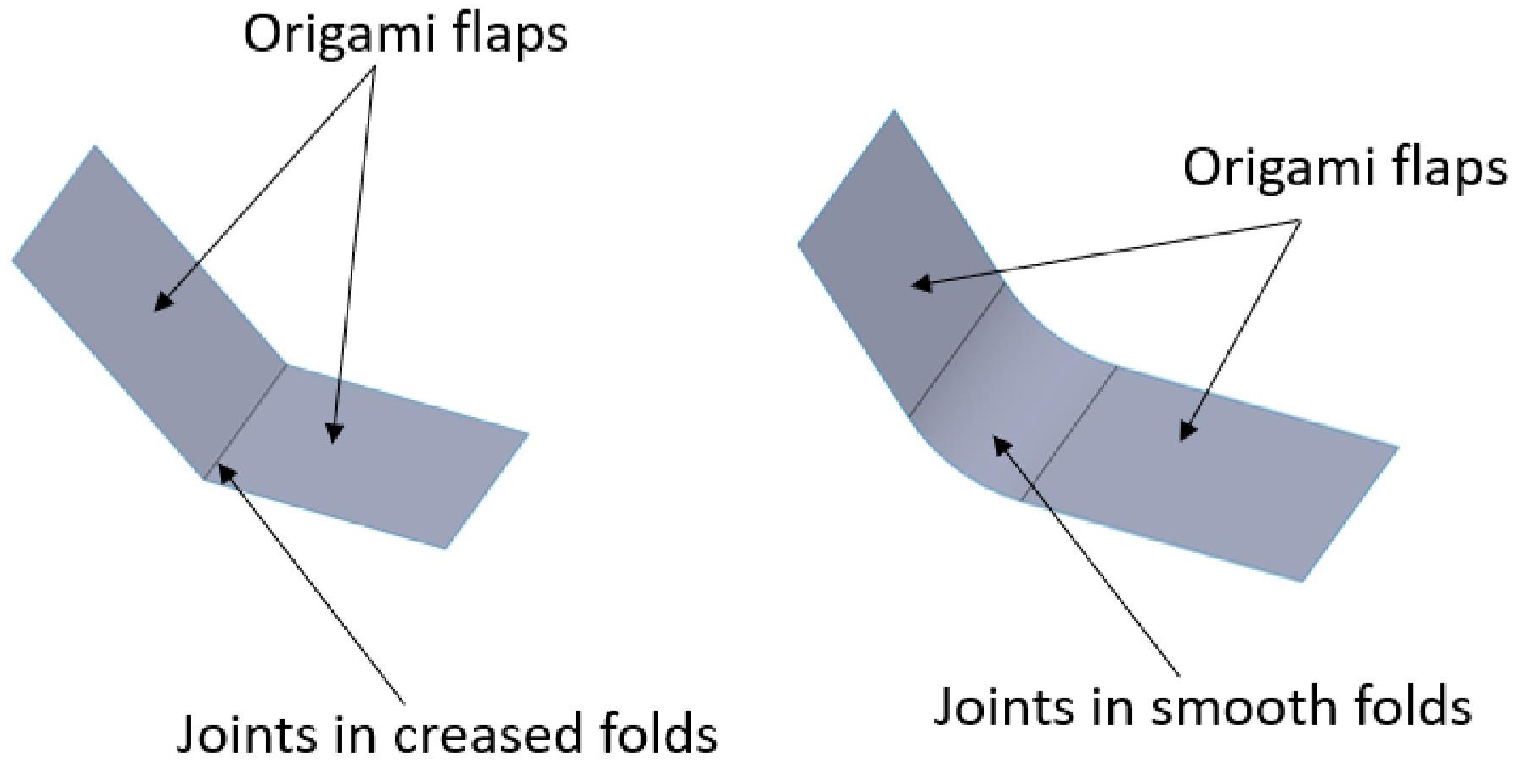

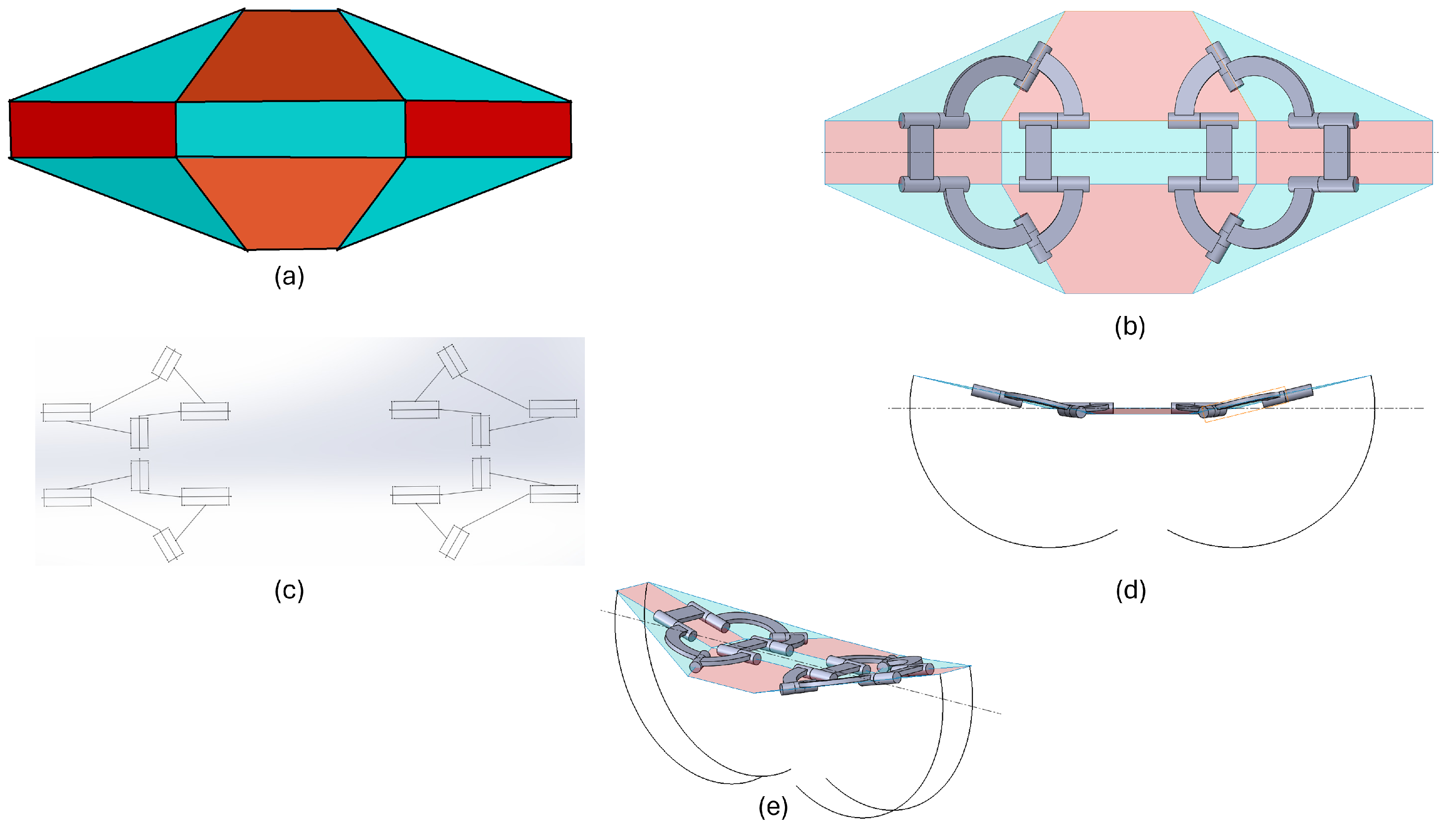


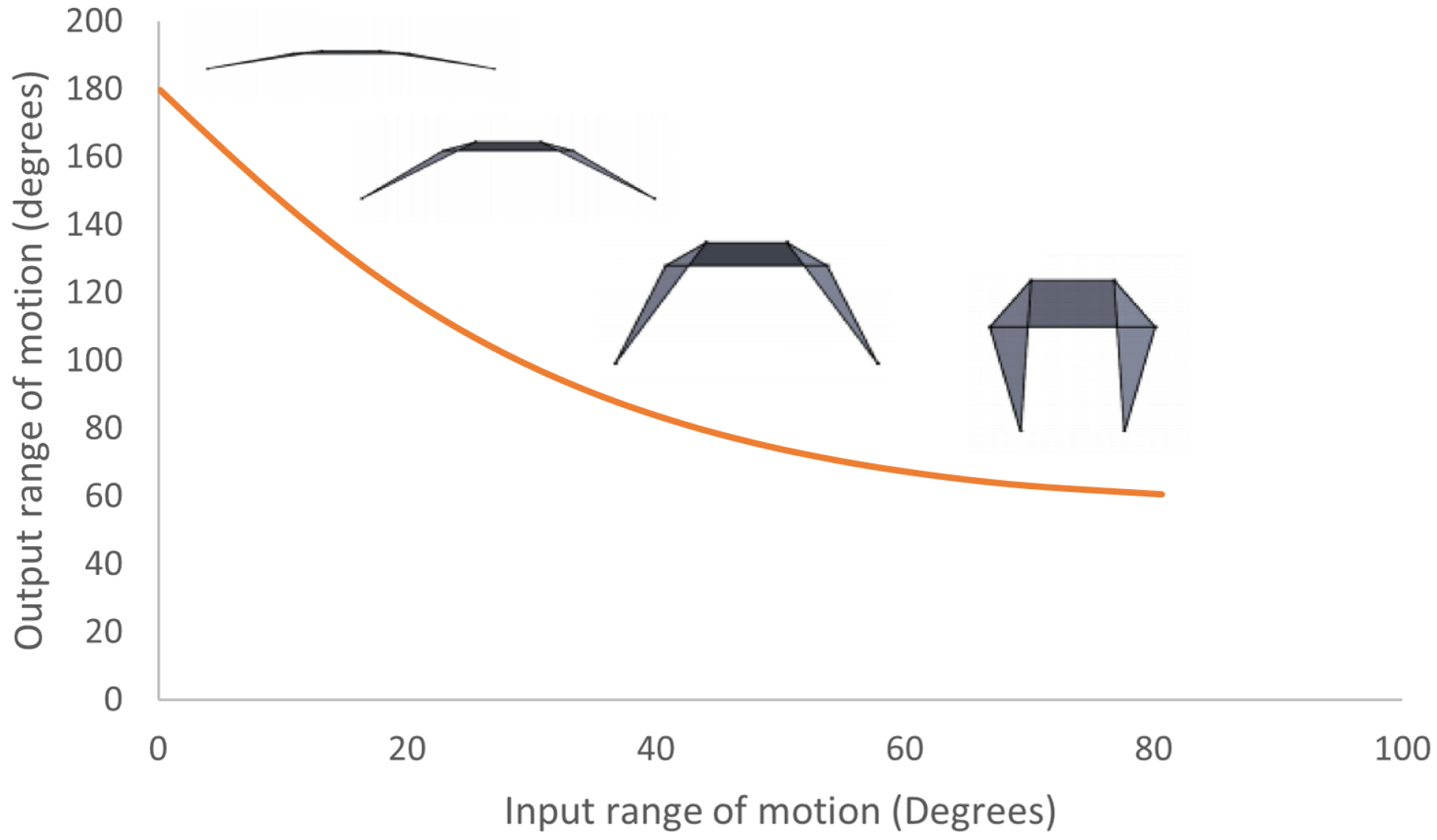


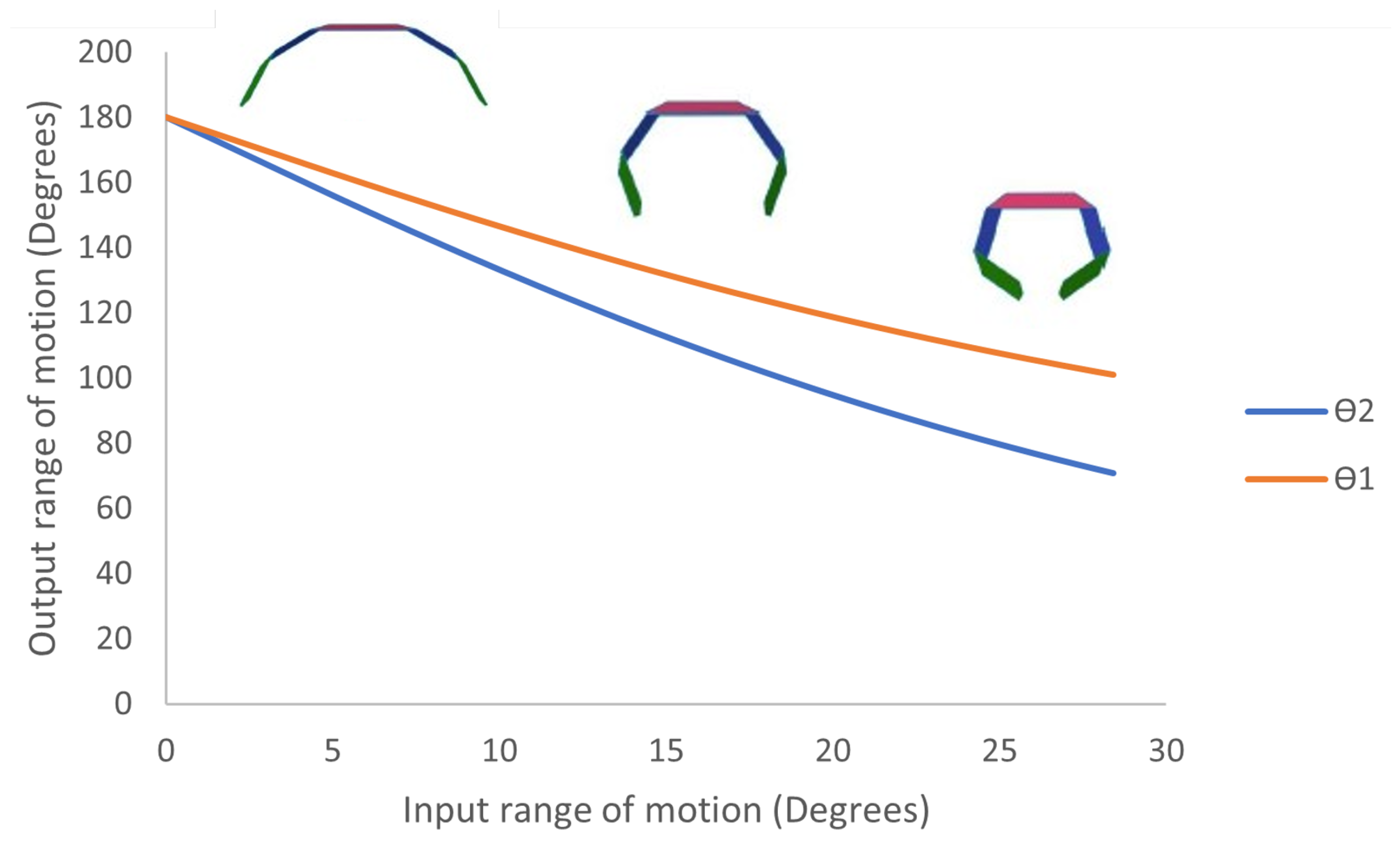
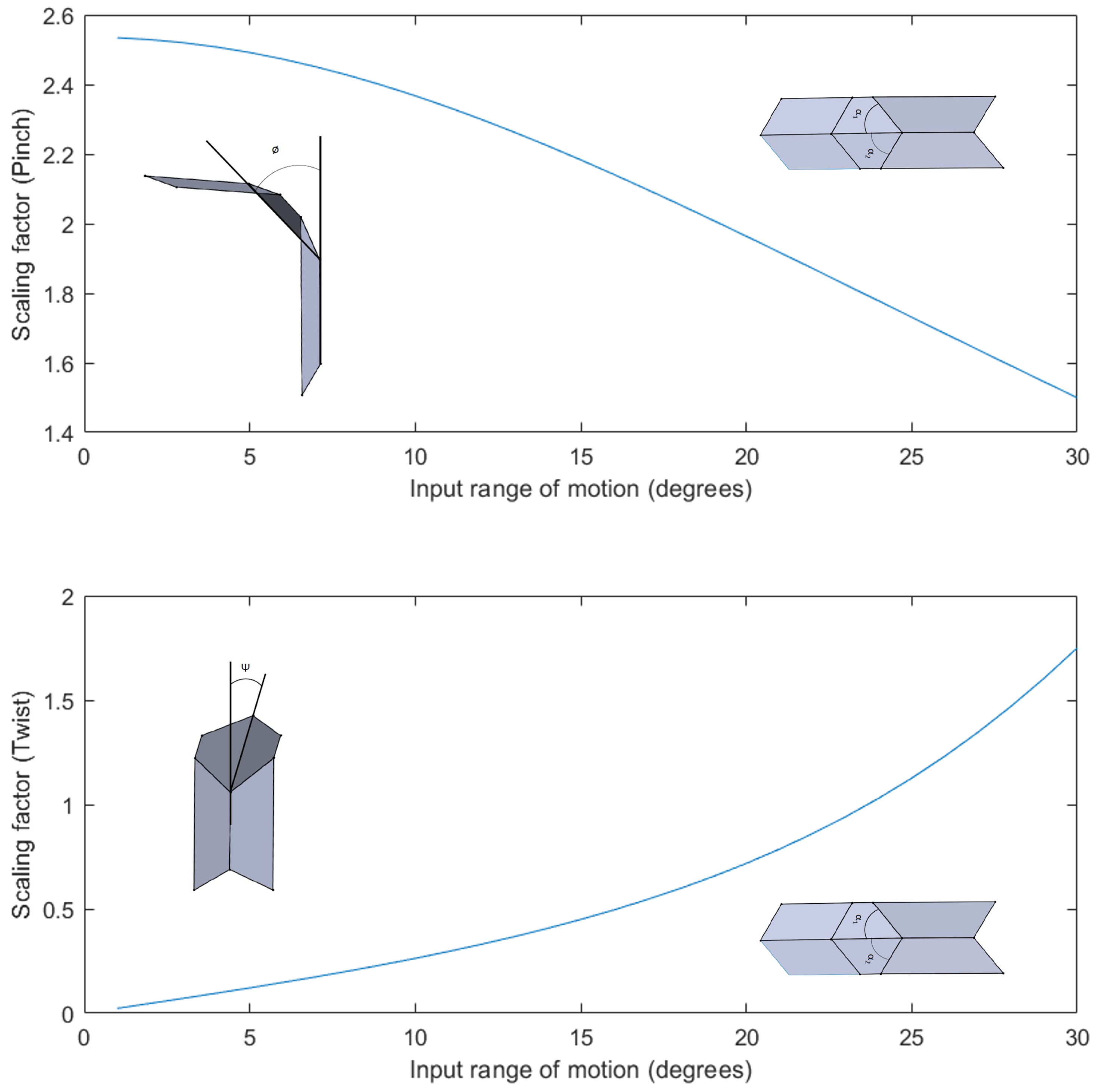
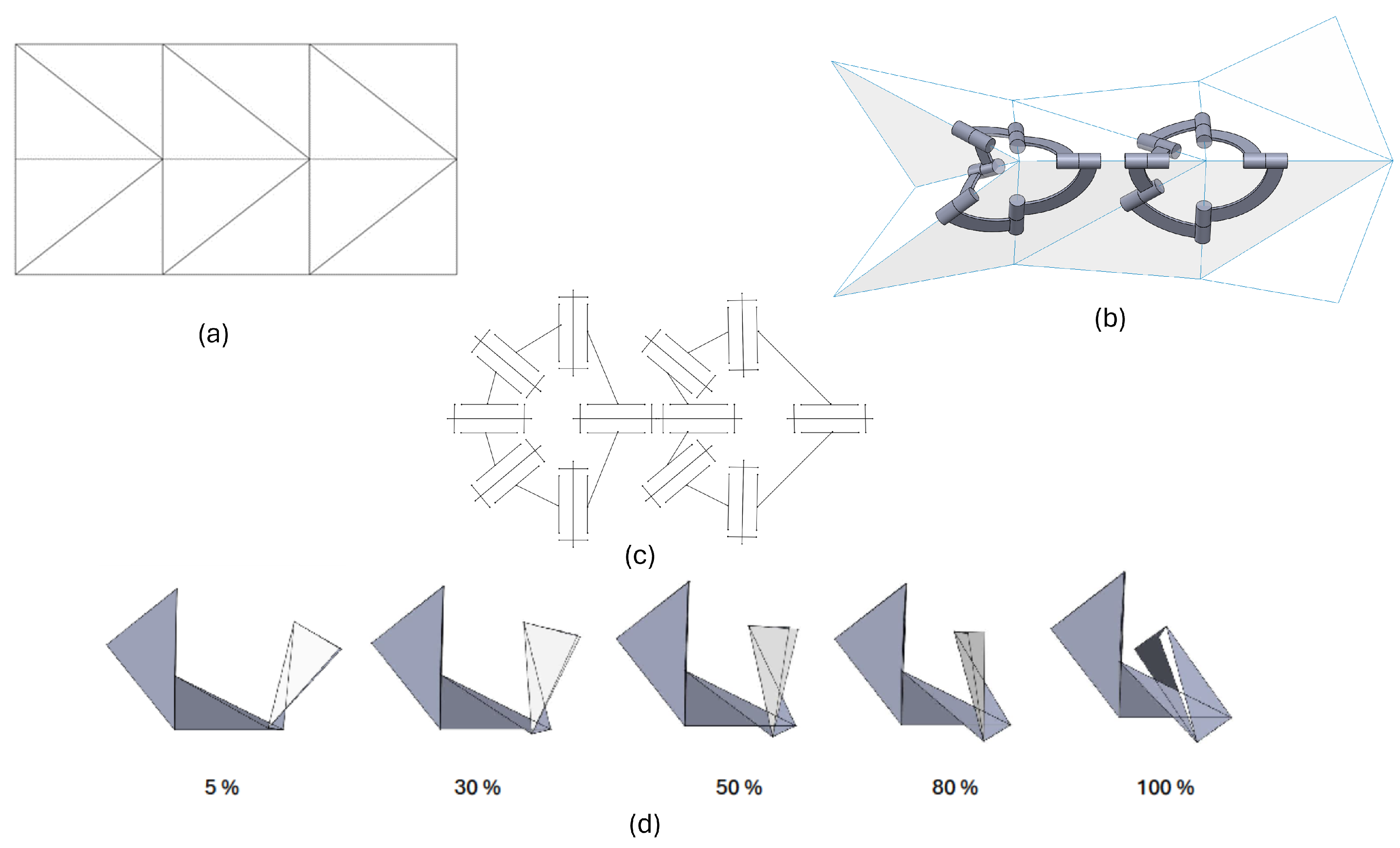
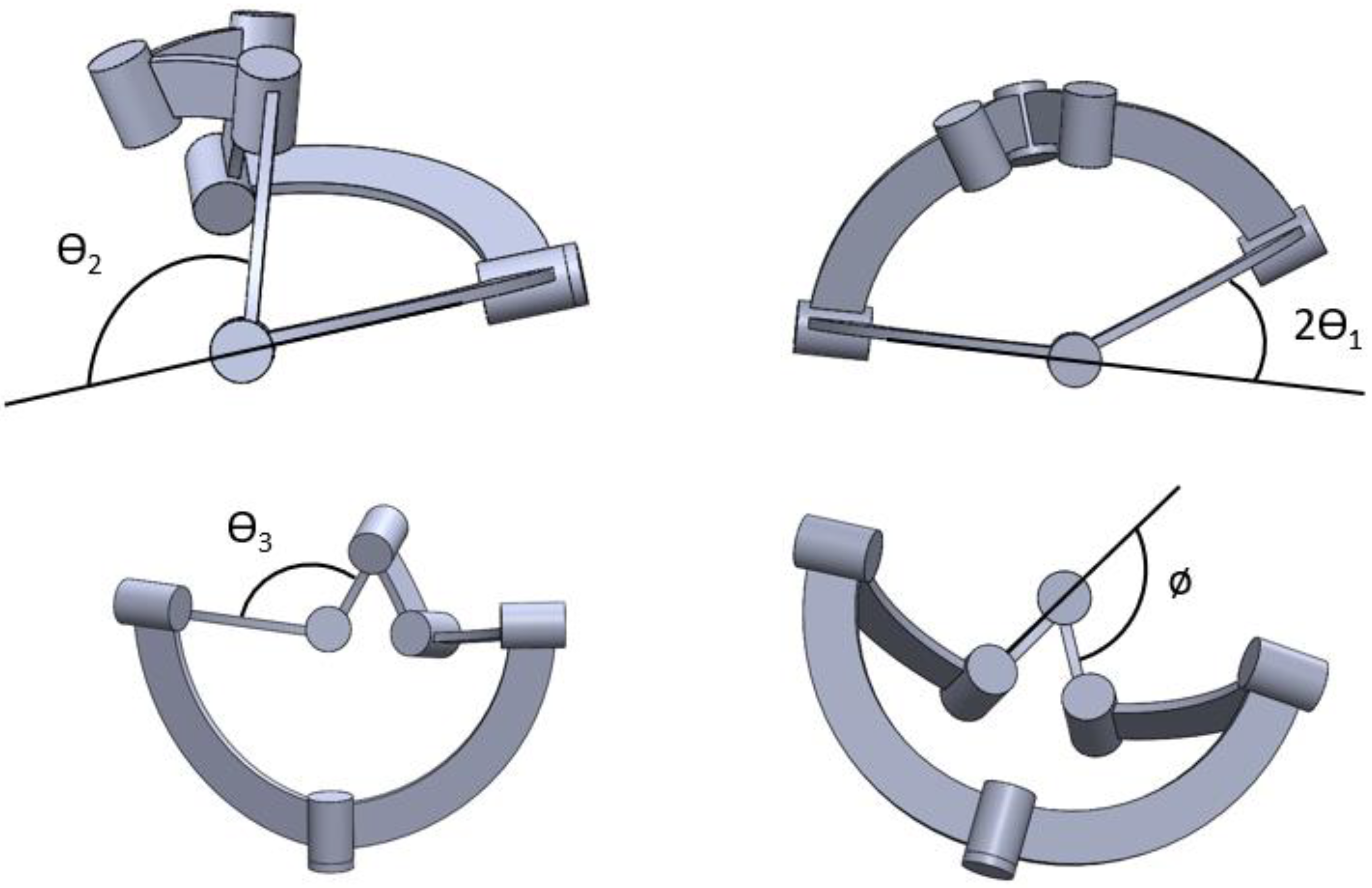
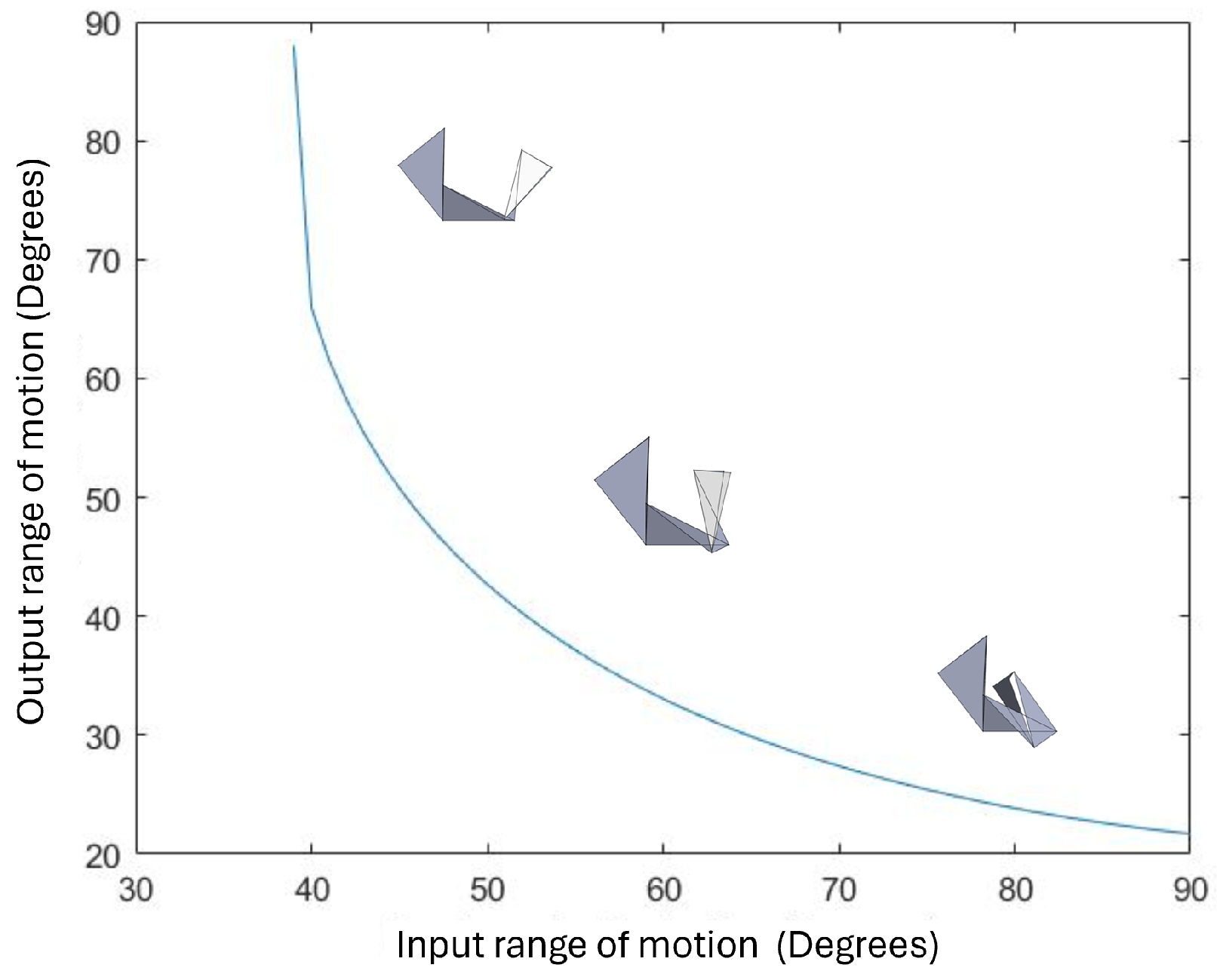
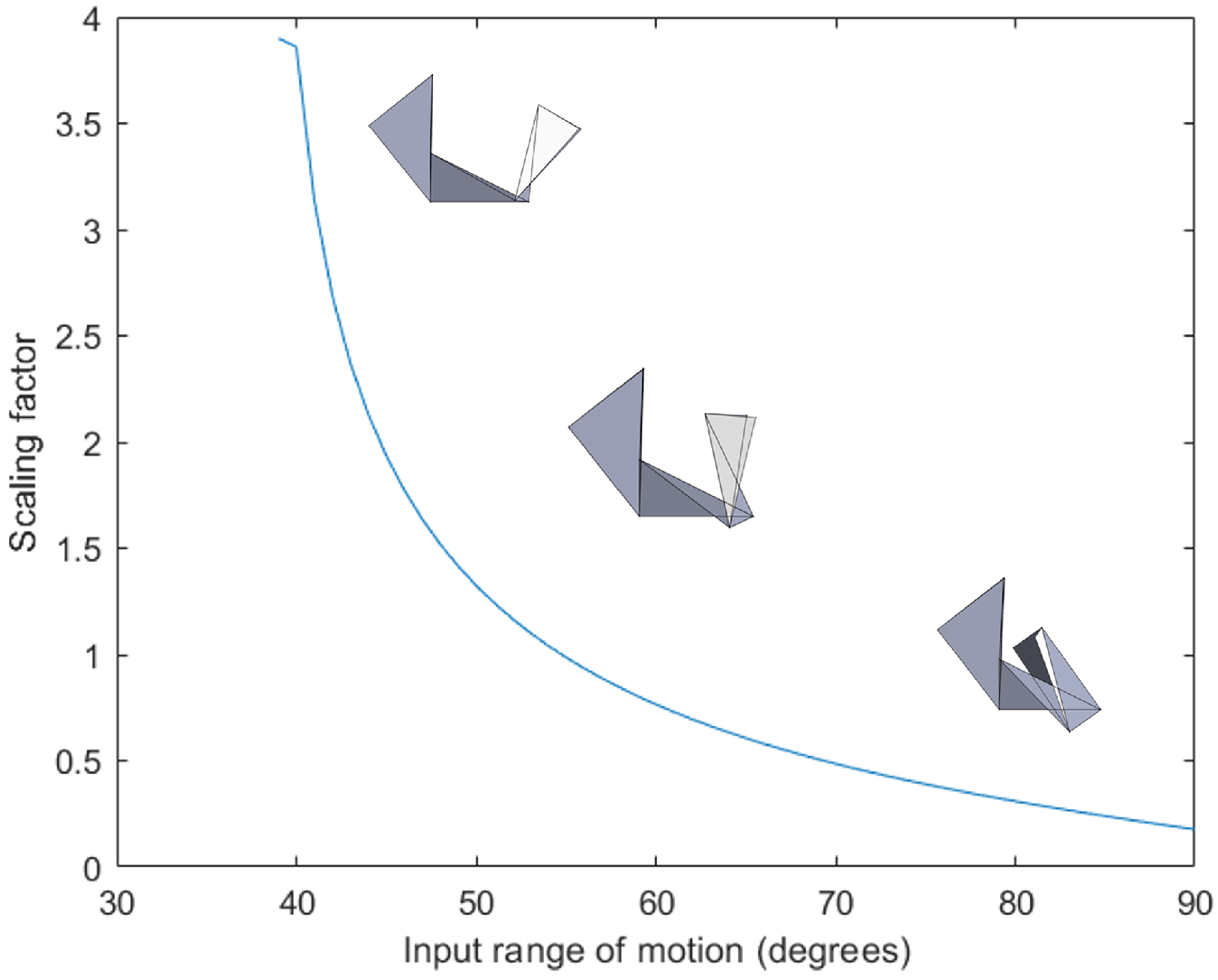
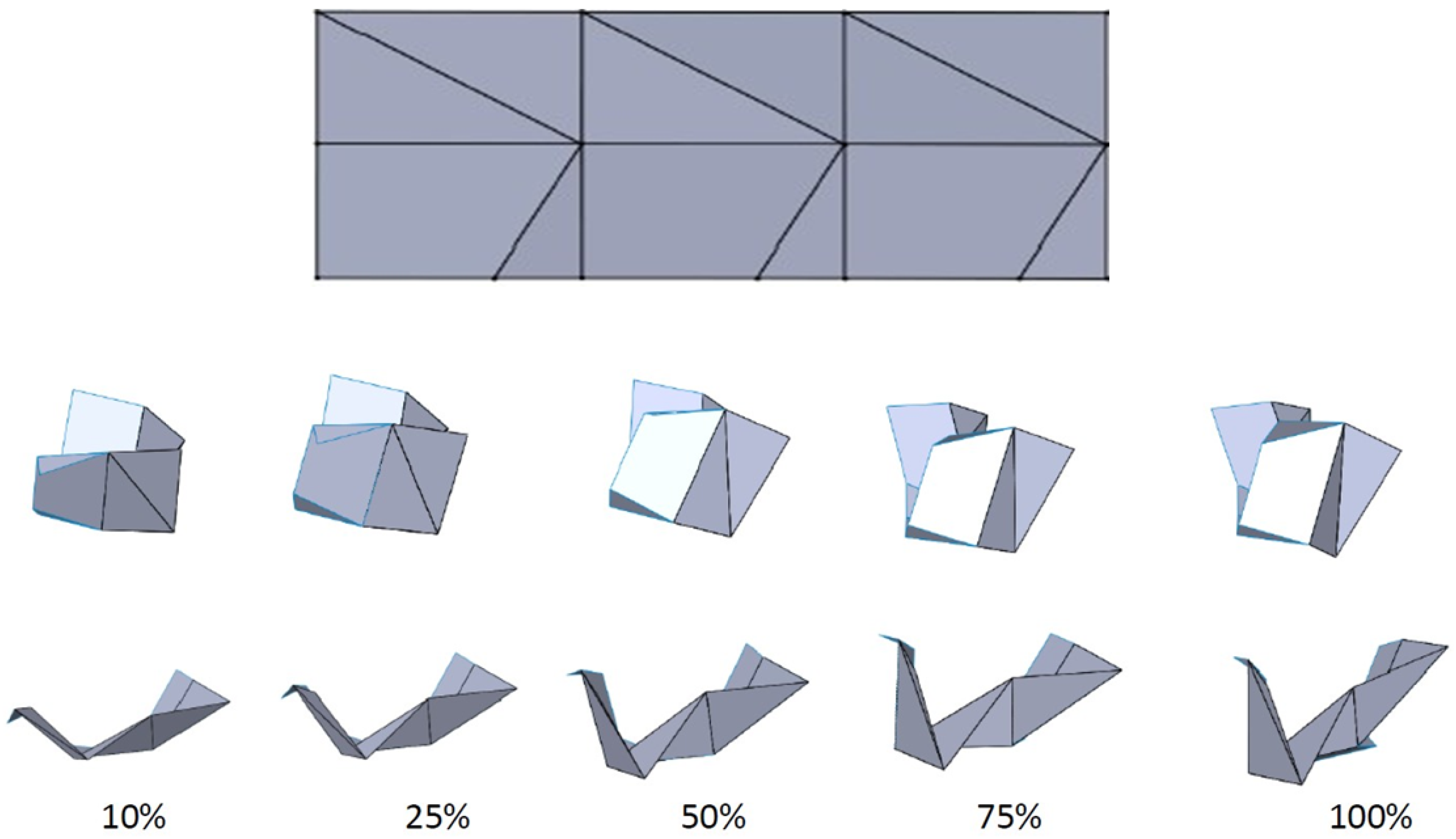
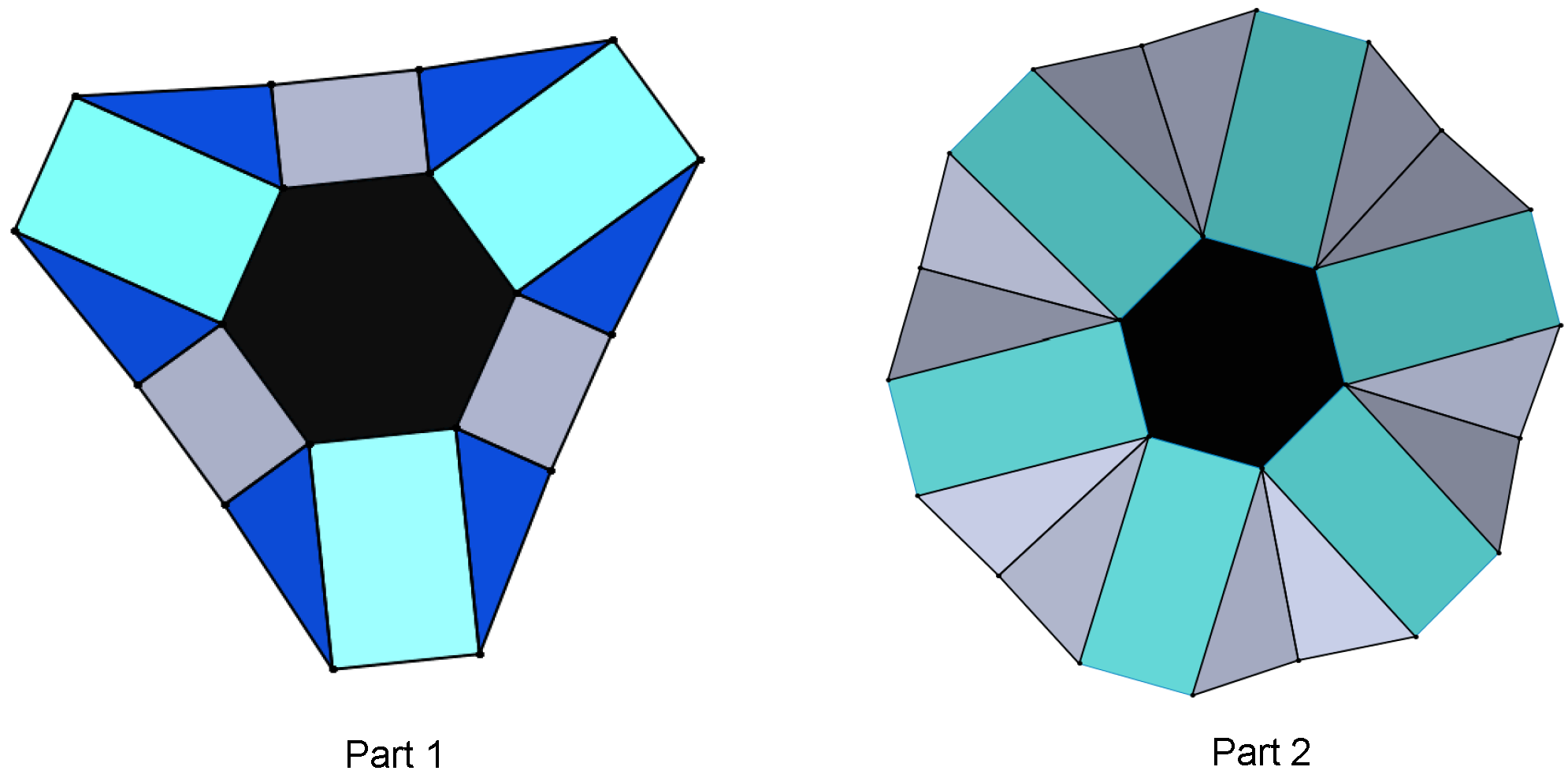

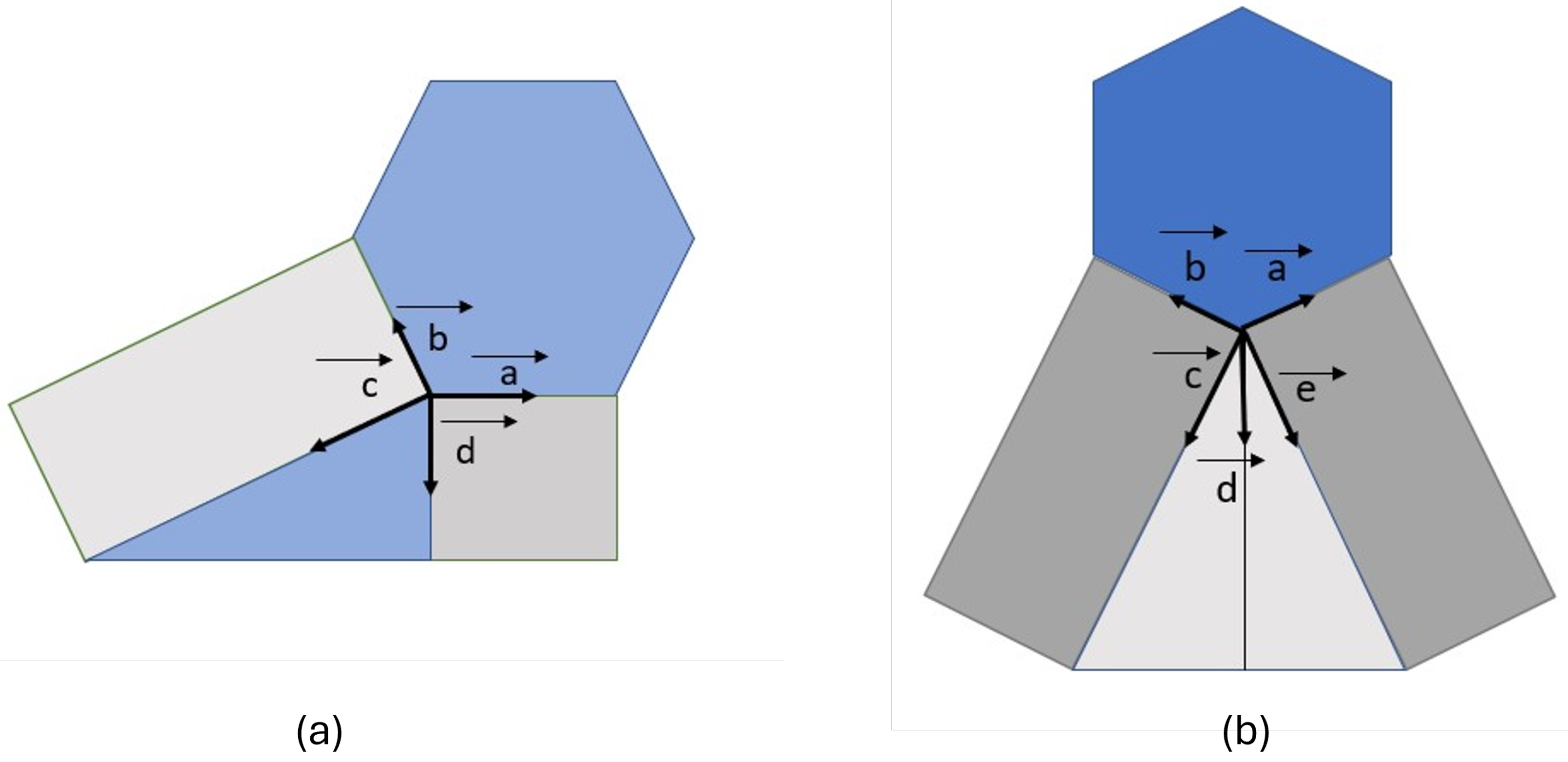
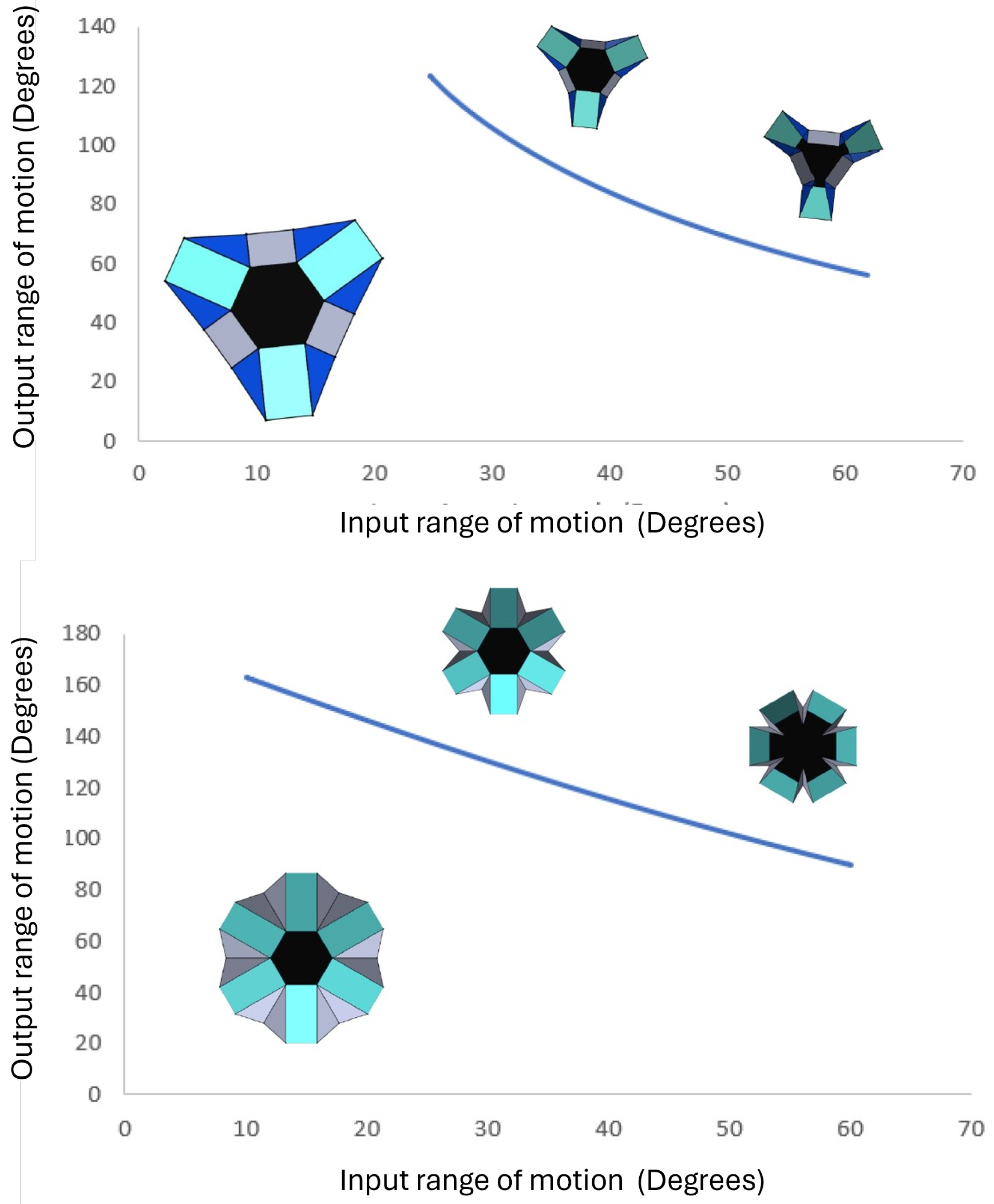
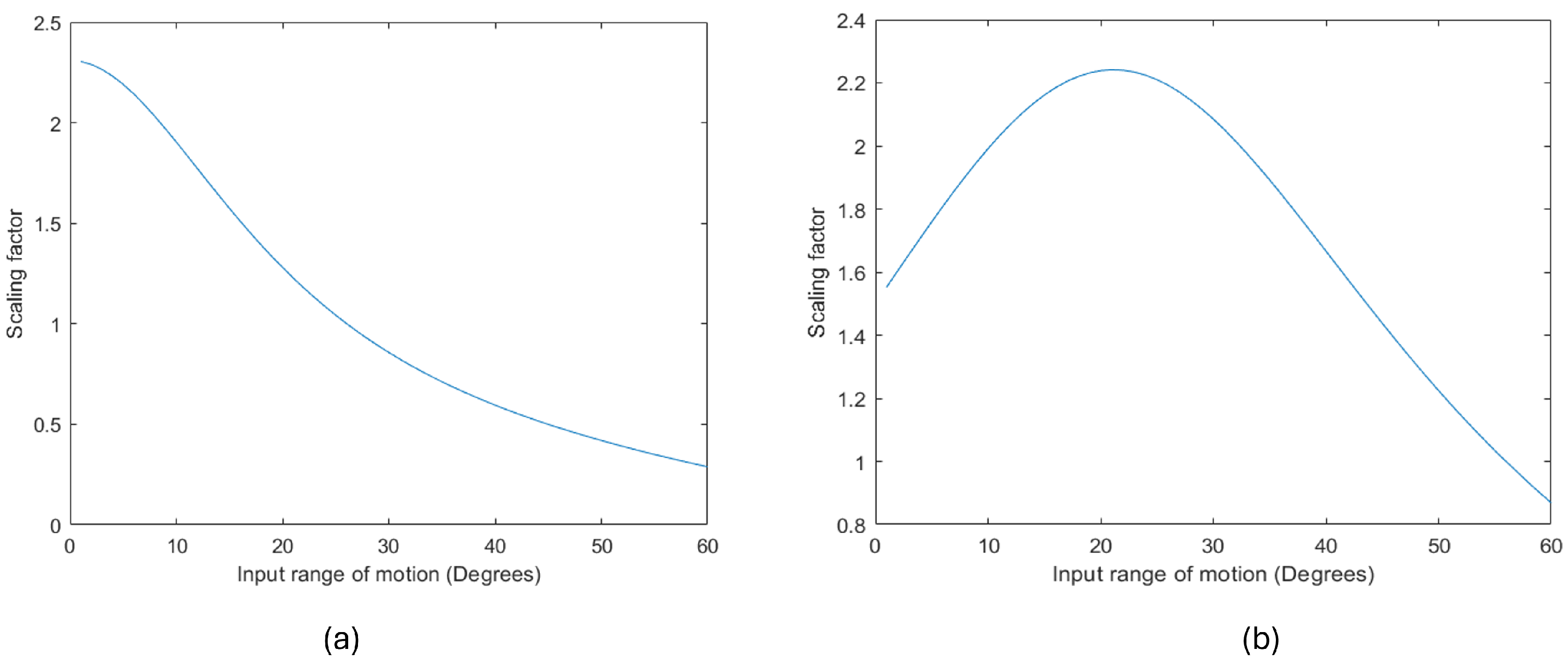
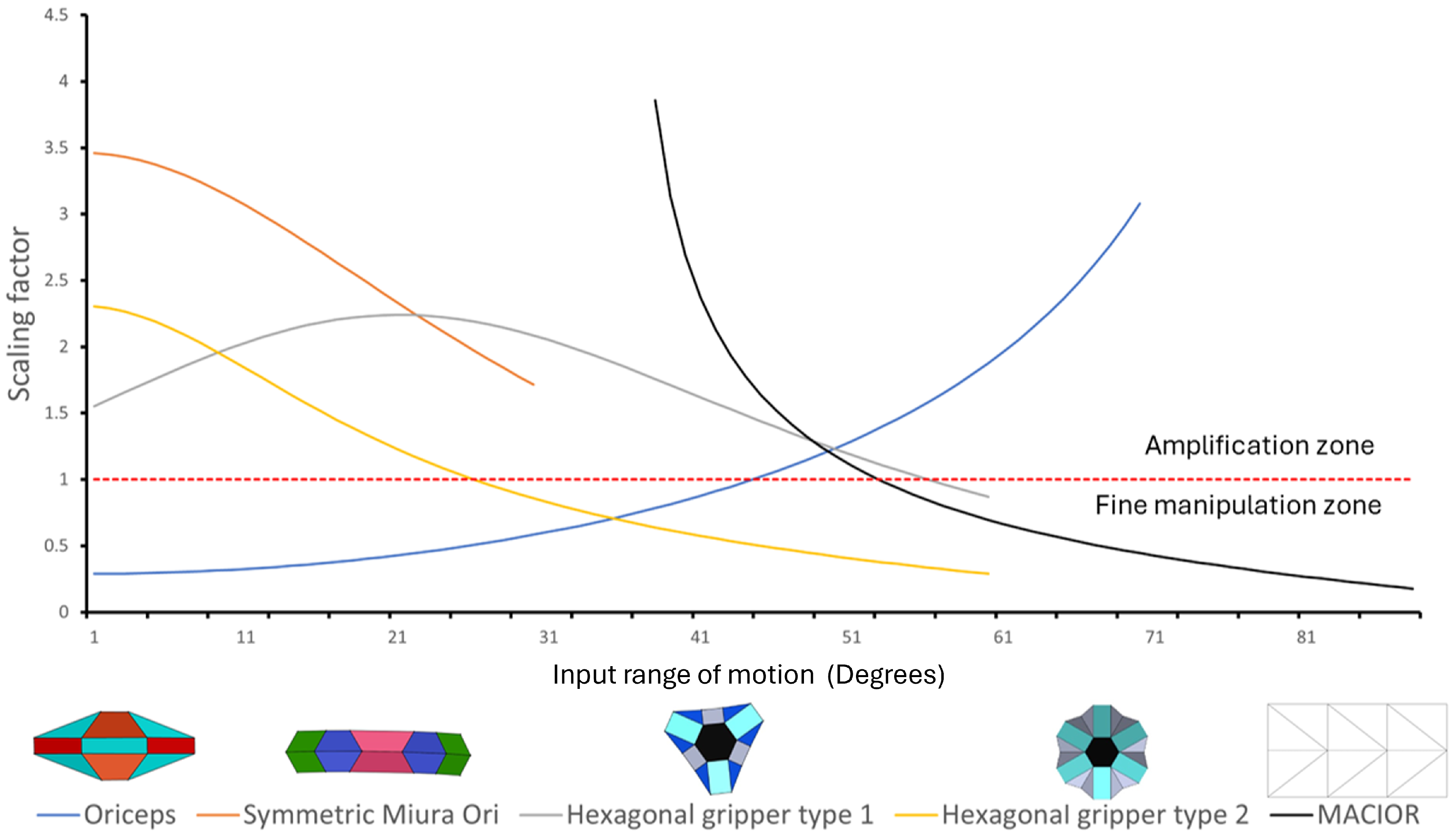
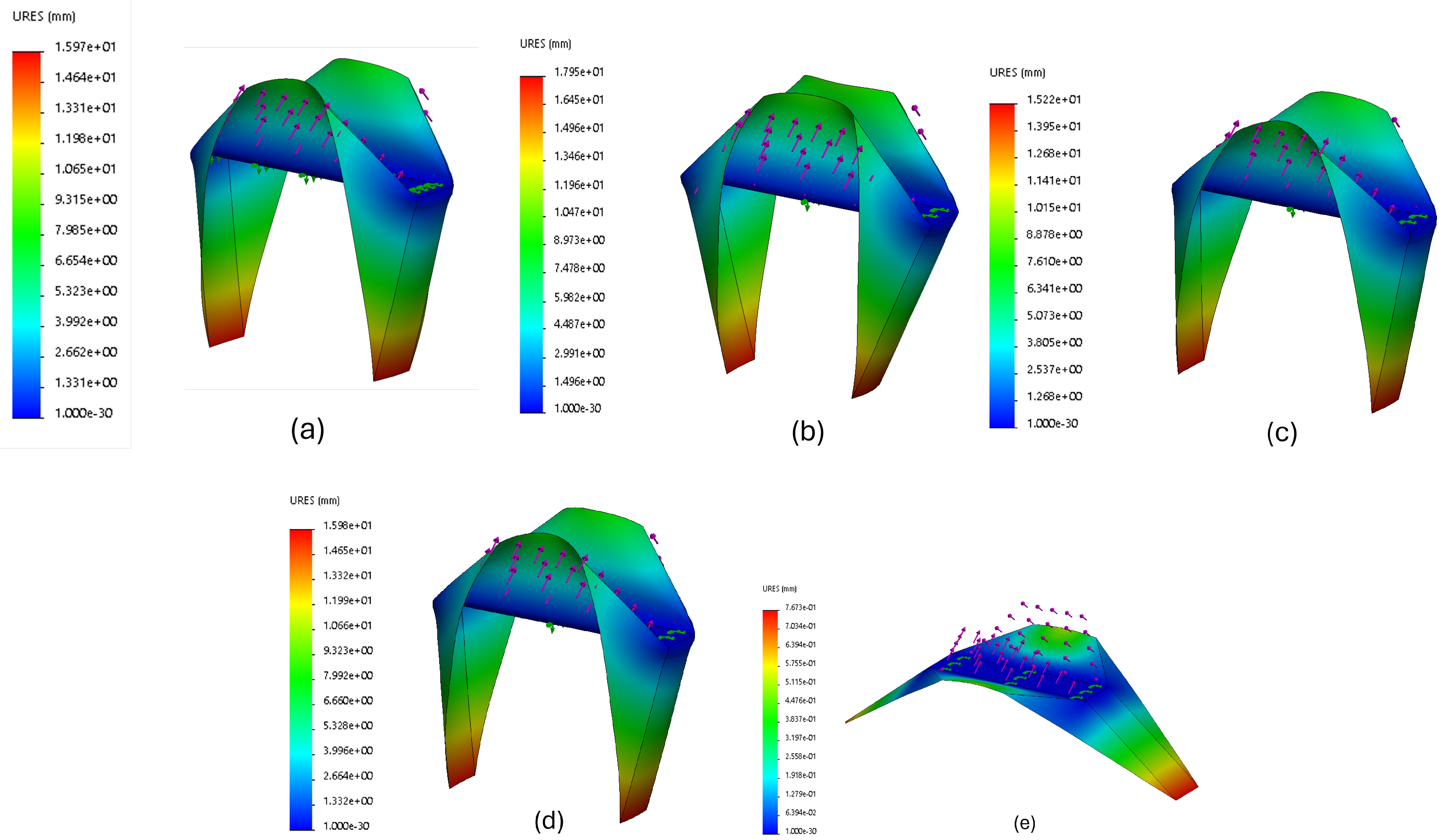
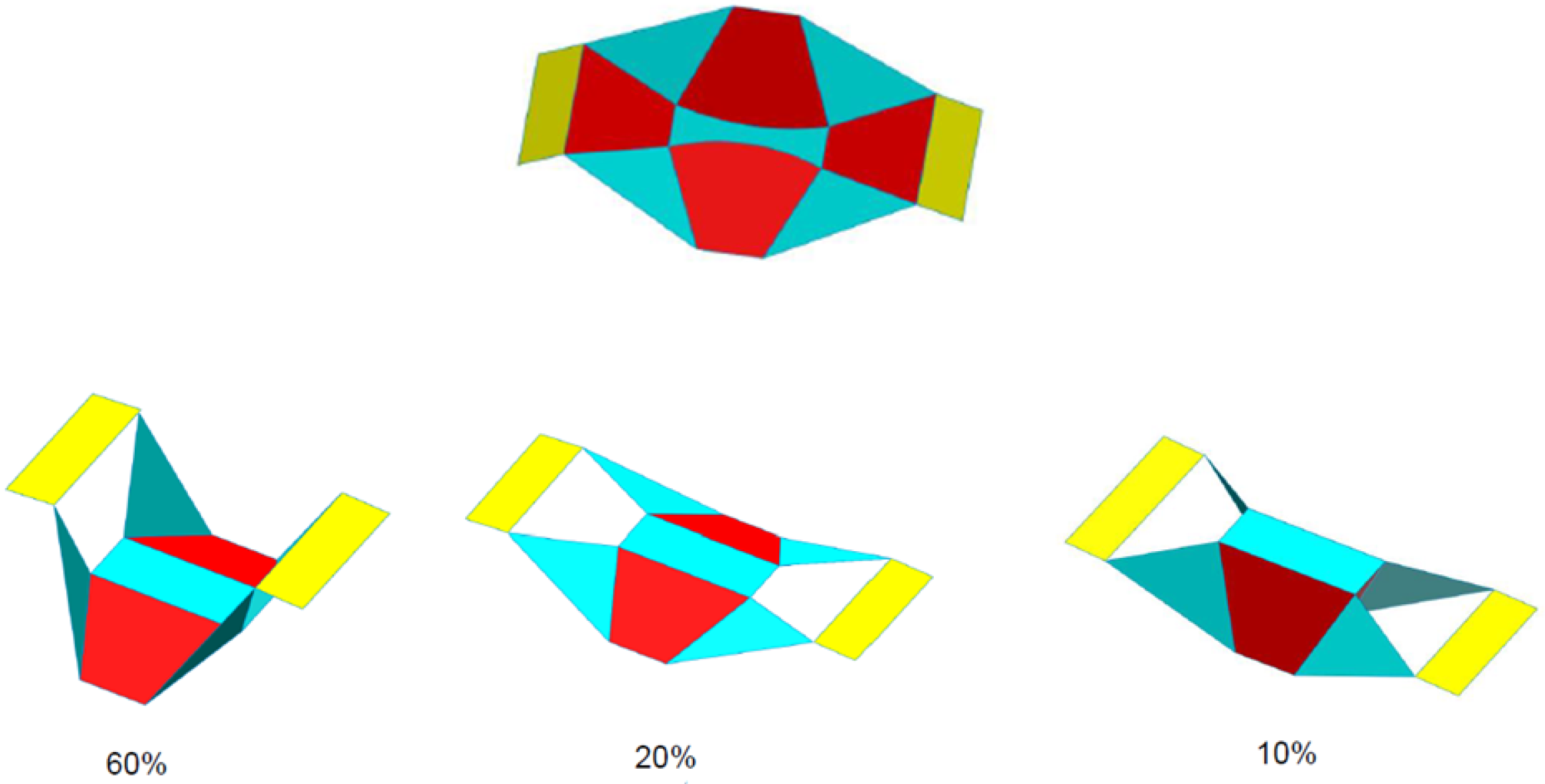
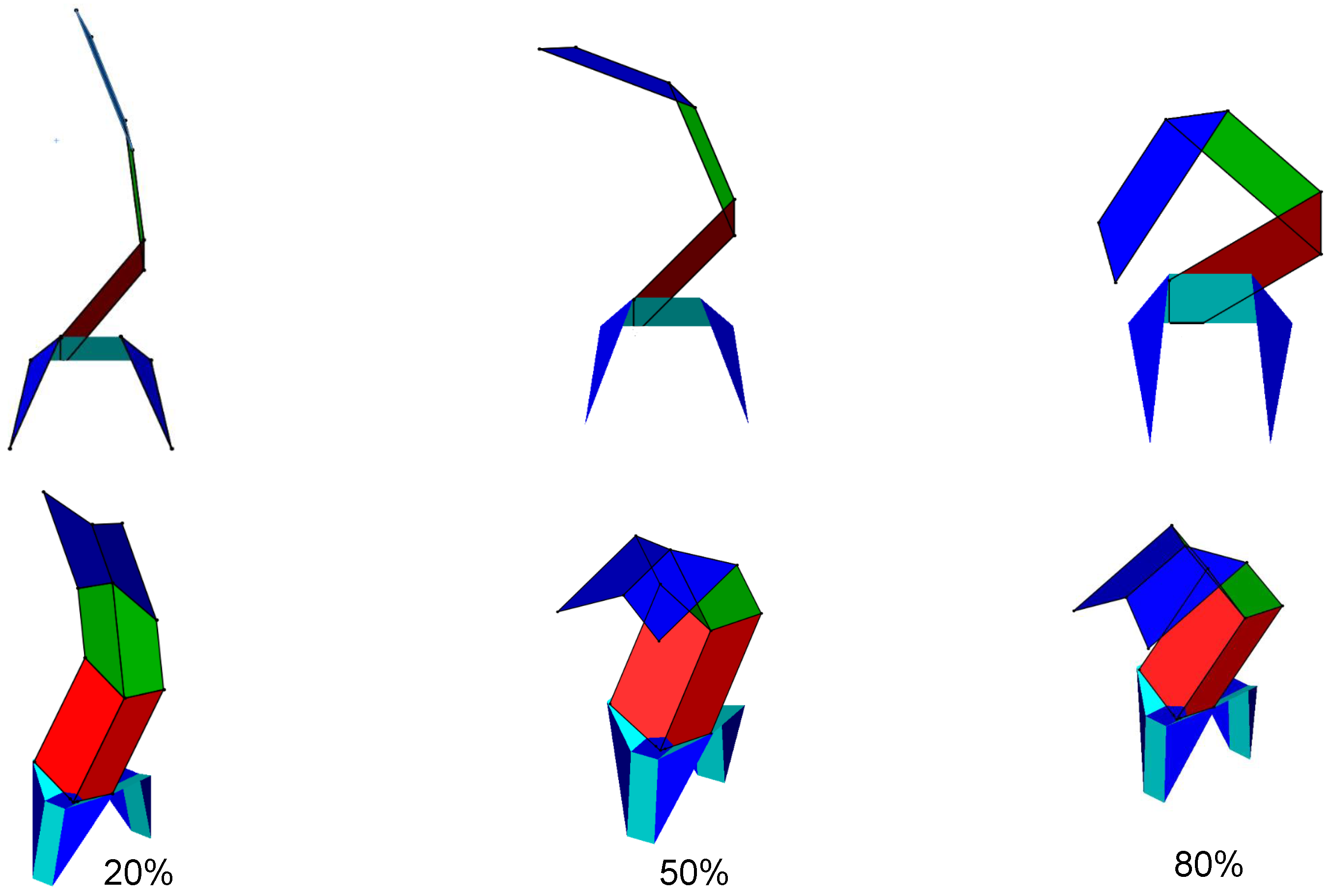
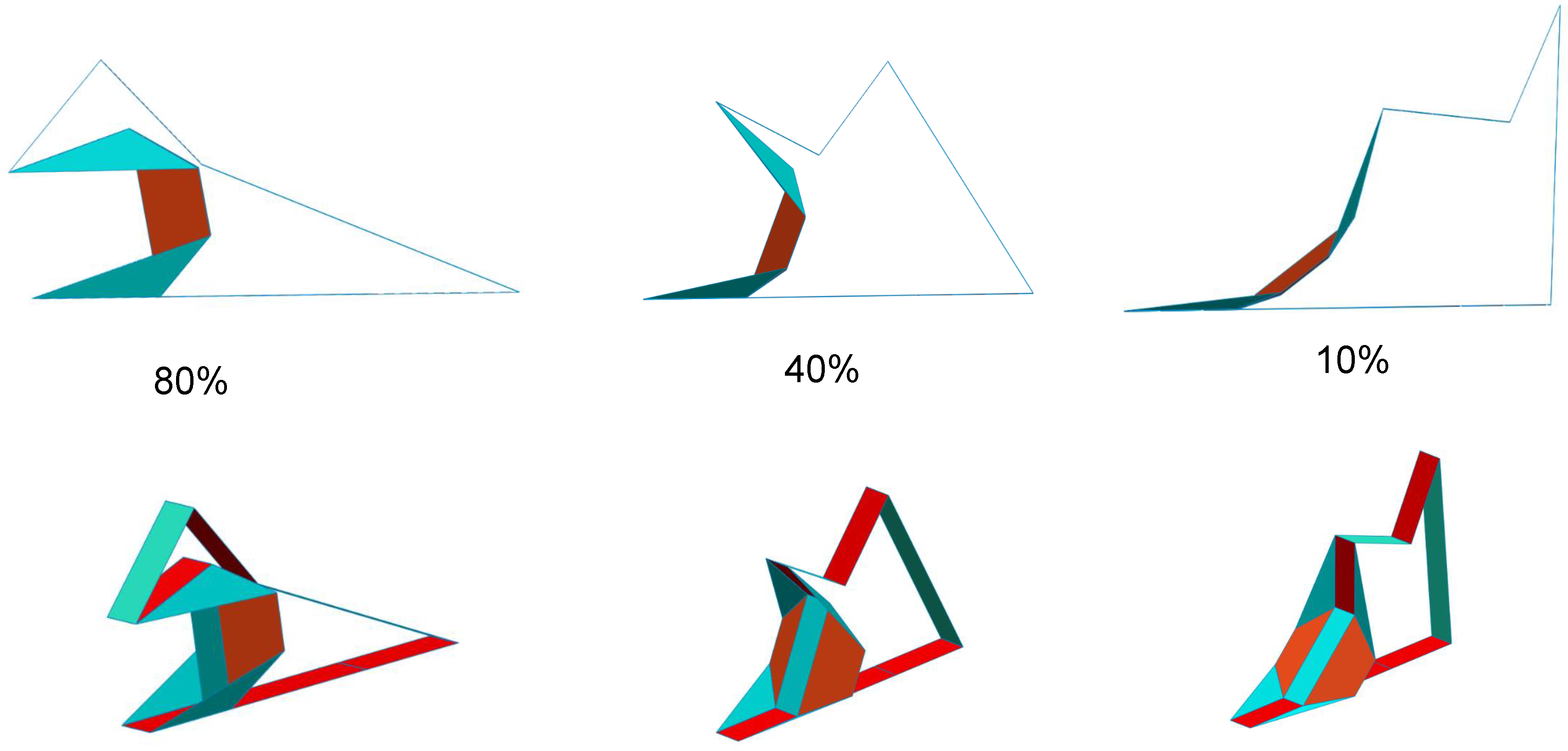
| Parameter | Oriceps | Miura Ori | MACIOR | Hexagon Type 1 | Hexagon Type 2 |
|---|---|---|---|---|---|
| Number of creases | 12 | 8 | 13 | 18 | 24 |
| Number of structures | 2 | 2 | 3 | 3 | 6 |
| Number of surfaces | 9 | 10 | 12 | 13 | 19 |
| Number of spherical mechanisms | 4 | 4 | 2 | 6 | 6 |
| Degree of a vertex | 4 | 4 | 6 | 4 | 5 |
| Parameter | Oriceps | Miura Ori | MACIOR | Hexagon Type 1 | Hexagon Type 2 |
|---|---|---|---|---|---|
| Arrangement of spherical mechanism | 4 corners of a rectangle | Linear | Linear | Hexagon vertices | Hexagon vertices |
| Classification [35] | Coupled | 4 long linear chain | 2 long linear chain | Single loop | Single loop |
Disclaimer/Publisher’s Note: The statements, opinions and data contained in all publications are solely those of the individual author(s) and contributor(s) and not of MDPI and/or the editor(s). MDPI and/or the editor(s) disclaim responsibility for any injury to people or property resulting from any ideas, methods, instructions or products referred to in the content. |
© 2024 by the authors. Licensee MDPI, Basel, Switzerland. This article is an open access article distributed under the terms and conditions of the Creative Commons Attribution (CC BY) license (https://creativecommons.org/licenses/by/4.0/).
Share and Cite
Krishnapuram, S.; Xiao, X.; Ren, H. Comparative Study of Mechanical Scaling Effects of Origami-Inspired Motion Generation Mechanisms with Multi-Degree Vertices. Actuators 2024, 13, 266. https://doi.org/10.3390/act13070266
Krishnapuram S, Xiao X, Ren H. Comparative Study of Mechanical Scaling Effects of Origami-Inspired Motion Generation Mechanisms with Multi-Degree Vertices. Actuators. 2024; 13(7):266. https://doi.org/10.3390/act13070266
Chicago/Turabian StyleKrishnapuram, Seetharam, Xiao Xiao, and Hongliang Ren. 2024. "Comparative Study of Mechanical Scaling Effects of Origami-Inspired Motion Generation Mechanisms with Multi-Degree Vertices" Actuators 13, no. 7: 266. https://doi.org/10.3390/act13070266
APA StyleKrishnapuram, S., Xiao, X., & Ren, H. (2024). Comparative Study of Mechanical Scaling Effects of Origami-Inspired Motion Generation Mechanisms with Multi-Degree Vertices. Actuators, 13(7), 266. https://doi.org/10.3390/act13070266






